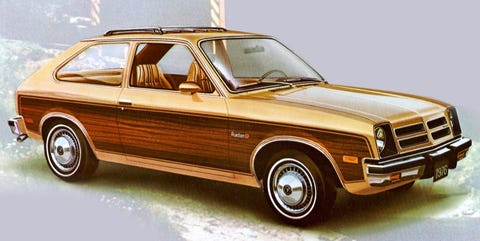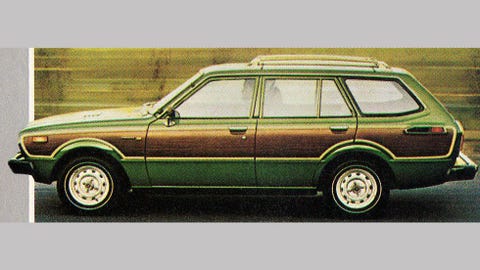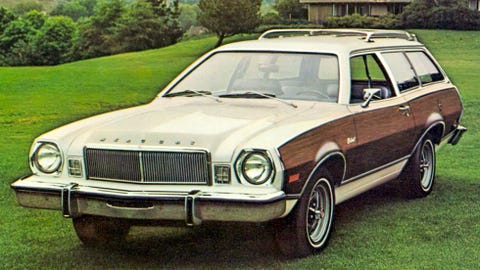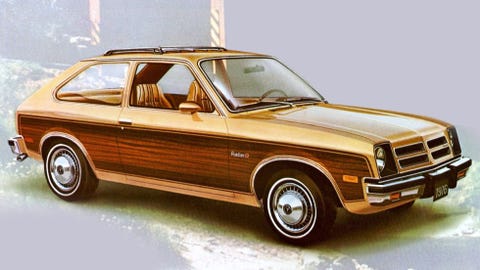
When car enthusiasts think of woody cars, something large usually comes to mind. The common denominator tends to be a long roof, whether on an SUV or a station wagon, and a footprint that definitely would not fit into a compact parking spot at Whole Foods.
The faux wood trend, however, was not confined to the large and “luxurious.” To make the less pricey models appeal to suburbanites, automakers armed themselves with glue guns, a utility knives, and wallpaper-sized rolls of woodgrain vinyl and slathered whole fleets of small cars with the faux-wood look. The results of their efforts are seldom seen anymore because these were not pricey or especially desirable cars back in the day—few kept them locked in climate-controlled garages reserved for weekend use—so spotting one for sale today would make us weak in the knees, itching to cosplay a late Malaise-era suburbanite on a budget.
Yes, at one point the Corolla station wagon was deemed not American-market enough, and alongside the larger Cressida wagon, it received some wood trim, especially trendy if paired with very ’70s body colors like mustard, brown, or dark green. Not a lot of buyers checked the woody trim box, unfortunately, which is why these are exceptionally rare today and are found mostly on the West Coast, where Corolla sales and survivability were stronger. Today, this budget commuter checks all the right boxes if you want to pretend that it’s 1979 and roll around with a Jimmy Carter bumper sticker.
Malaise Level: 3/10. Let’s not forget that the Corolla scored massive points against domestic automakers when it came to small cars in the 1970s, so the engineering underneath is pretty solid. There is a reason why you can still see Corollas of this vintage with faded paints rolling around California: Some of these just did not die of old age.
Cosplay Suitability: Medium, but only because these are hard to find today, but just look at it: Accessorized properly, this could even be a surfer car today.
Ford and Mercury had plenty of cars with wood siding at their dealers in the late 1970s, and not all of them were especially large. Budget-minded commuters were not shut out of the woody wagon-driving elite and had the option of a Ford Pinto or a Mercury Bobcat station wagon. And by station wagon we really mean hatch, because this was a small three-door model that was not the fastback. This woodgrain option was available on pre- and post-facelift versions of the Bobcat, so one can choose the earlier round headlights or the more rectangular later units, assuming one can find a Mercury Bobcat wagon for sale in the first place.
Malaise Level: 8/10. The Bobcat was a Pinto sibling, with everything that that entails, so finding any Bobcat of this time period is a problem, not to mention ones with well-preserved woodgrain siding. Parts availability is not great at this point, as it’s a pain to find these in junkyards.
Cosplay Suitability: Medium, simply because they’re hard to find today.
The later version of the AMC Pacer with a longer wheelbase started calling itself a station wagon by the end of the 1970s and even made it into the 1980s thanks to a series of gasoline crises and America’s appetite for small cars. The Pacer did not grow all that much as a result of the wheelbase stretch—this was still a hatch, really—but it offered a versatile, if anemic, alternative to other hatchback models at the time, boasting a greater amount of interior space. The wood trim actually lent the slabby sides some much needed balance.
Malaise Level: 10/10. This one gets bonus points for being an AMC model, which at the time also meant regrettable driving dynamics and some other issues. Parts availability can be a problem with these when it comes to body panels, we’ve heard, simply because the trim and small items on bad examples are gone. Restoring one of these to a high standard is not expensive per se, but it can take some time because donor cars with usable parts are not plentiful.
Cosplay Suitability: Very high, once again because it’s an AMC and was available in some very period paint colors. Some of these tended to be preserved simply because they were already kitsch even back in the day, so finding one is not as difficult as some of the others on this list.
General Motors cranked out many versions of the Chevette in the 1970s, and one of the models that it sent to the harsh Canadian tundra was the Pontiac Acadian. Just like in the U.S., this was one of the smallest and cheapest (in all senses of the word) wood-trim cars you could buy to resemble a member of the wagon-owning elite, even if the three-door’s claim to wagon-dom was a stretch.
Malaise Level: 9/10. The Acadian combined a very budget interior with some naff dynamics and iffy reliability, but the sheer number of these overwhelmed Canada and the U.S. like a tsunami, and it lasted well into the 1980s—although the woodgrain siding was not available for all model years.
Cosplay Suitability: Medium to high for the Chevette, but the Acadian is very hard to find today, so a Chevette with woodgrain sides is a much more realistic purchase. Both are seldom found in the wild, so most examples will have been preserved because of their funky ’70s looks. Parts availability is great, however.
Chrysler’s hatchbacks were innovative cars for the time, but despite the fact that they featured four doors it’s difficult to think of them as something wagon-like. They were also very affordable and surprisingly well-engineered, arriving at the tail of the Malaise era with European styling, a front-wheel-drive layout and plenty of versatility. Woodgrain siding was a relatively rare option at the time.
Malaise Level: 5/10. These had some solid engineering beneath them and managed to hang around far longer than most of their competitors.
Cosplay Suitability: High, despite the rarity of woodgrain-optioned cars. Parts are not an issue, as the Omnirizon was produced all the way until the 1990 model year.
Source: Read Full Article





